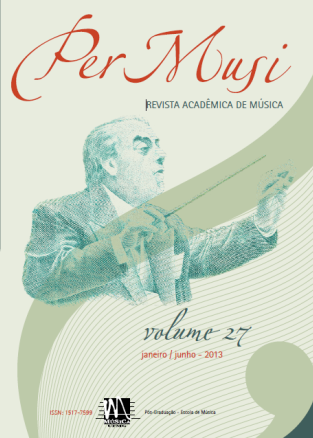Symbology and heredity on the formation of a Grundgestalt
the first of Berg ́s Four Songs Op.2
Keywords:
Grundgestalt and developing variation, Musical symbology, Extraopus transmissionAbstract
As a part of a broad research project that aims at elaborating a specific analytical methodology for the procedures of developing variation, the present study examines the possibility of, so to speak, hereditary (extraopus) transmission in the construction of the primordial idea (or Grundgestalt) of a musical piece. Thus, the analysis was focused on the first of the Four Songs op.2, by Alban Berg, of which the Grundgestalt is presented as a complex formed by several transformations of key-elements extracted from three pieces: Tristan and Isolde, by Richard Wagner, the First Chamber Symphony op.9, by Arnold Schoenberg, and the Piano Sonata op.1, by Berg.
References
ALMADA, Carlos de L. “Nas fronteiras da tonalidade”: Tradição e inovação na forma da Primeira Sinfonia de Câmara, op.9, de Arnold Schoenberg. 2007. Dissertação (Mestrado em Música) – Centro de Letras e Artes, Universidade Federal do Estado do Rio de Janeiro.
_______________. Pontos de contato entre a Sonata para Piano,op.1, de Alban Berg e a Primeira Sinfonia de Câmara,op.9, de Arnold Schoenberg. In: V SIMPÓSIO DE PESQUISA EM MÚSICA - SIMPEMUS 5, 2008. Curitiba. Anais ...Curitiba: UFPR, 2008.
_______________. A variação progressiva aplicada na geração de ideias temáticas. In: II Simpósio Internacional de Musicologia. Rio de Janeiro: UFRJ, 2011a.
_______________. Derivação temática a partir da Grundgestalt da Sonata para Piano op.1, de Alban Berg. In: II Encontro Internacional de Teoria e Análise Musical. Anais ...São Paulo: UNESP-USP-UNICAMP, 2011b. 1 CD-ROM (11 p.).
ADORNO, Theodor W. Alban Berg (Juliane Brand & Christopher Hailey, trad.). Cambridge: CambridgeUniversity Press, 1997.
AYREY. Craig. Berg’s ‘Scheideweg’: Analytical issues in Op. 2/ii. Music Analysis, vol. 1, nº 2, 1982, p.189-202
BOSS, Jack. Schoenberg’s Op. 22 radio talk and developing variation in atonal music.Music Theory Spectrum, vol. 14, nº2, 1992, p.125-149.
BURTS, Devon. An application of the grundgestalt concept to the First and Second Sonatas for Clarinet and Piano, Op. 120, no. 1 & no. 2, by Johannes Brahms. 2004. Dissertação (Mestrado em Música) – University of South Florida.
CARPENTER, Patricia. Grundgestalt as tonal function. Music Theory Spectrum, vol. 5, 1983, p.15-38.
DUDEQUE, Norton. Variação progressiva como um processo gradual no primeiro movimento do Quarteto A Dissonância, K. 465, de Mozart. PerMusi, vol.8, UFMG, 2003, p.41-56.
________________. Music theory and analysis in the writings of Arnold Schoenberg (1874-1951). Aldershot: Ashgate Publishings, 2005.
EMBRY, Jessica. The role of organicism in the original and revised versions of Brahms’s Piano Trio In B Major, Op. 8, Mvt. I: A comparison by means of Grundgestalt analysis. 2007. Dissertação (Mestrado em Música) – University of Massachusetts Amherst.
FRISCH, Walter. Brahms and the principle of developing variation.Los Angeles: University of California Press, 1984.
GAULDIN, Robert. Reference and association in the Vier Lieder, Op. 2, of Alban Berg.Music Theory Spectrum, vol. 21, nº 1, 1999, p.32-42.
HAIMO, Ethan. Developing variation and Schoenberg’s serial music. Musical Analysis, vol. 16, nº 3, p.349-365,1997.
HILMAR, Rosemary. Alban Berg’s studies with Schoenberg.Journal of the Arnold Schoenberg Institute, Los Angeles, vol. VIII, nº 1, p.7-29, 1984.
JAMEUX, Dominique. Berg. Bourges: Solfèges, 1980.
JARMAN, Douglas. Alban Berg: The origins of a method. Music Analysis, vol. 6, nº 3, p.273-288, 1987.
MARTINEZ, Alejandro. La forma-oración en obras de la Segunda Escuela de Viena: un lectura desde la morfología de Goethe. Revista del Instituto Superior de Música, no.12, Santa Fe, p.96-113, 2009.
MEYER, Leonard. Style and music. Chicago: The University of Chicago Press, 1989.
PERLE, George. Berg’s Master array of the interval cycles. The Musical Quarterly, nol. 63, n 1, 1977, p.1-30.
SALZER, Felix. Structural hearing: Tonal coherence in music (2 vol.). Nova Iorque: Charles Boni, 1952.
SCHOENBERG, Arnold. Style and idea: selected writings of Arnold Schoenberg. (Leonard Stein, ed.). Londres: Faber & Faber, 1984.
_______________. Fundamentals of musical composition.(Gerald Strang, ed.) Londres: Faber & Faber, 1990.
STRAUS, Joseph. Introduction to post-tonal theory (3 ed.). Englewood Cliffs: Prentice-Hall, 2005.
STUCKENSCHMIDT, H. H. Schönberg: vida, contexto, obra. (Ana Agud, trad.). Madri: Alianza Editorial S.A., 1991.
TOOP, Richard. Stockhausen, Kalheinz. In: New Grove Dictionary of Music. Oxford: Oxford University Press, 2001.
Downloads
Published
Issue
Section
License

This work is licensed under a Creative Commons Attribution 4.0 International License.

Except where otherwise noted, contents on this site are licensed under a Creative Commons - Atribuição 4.0 Internacional.












